LONDON: In a warehouse at London's sprawling Heathrow Airport, a border officer pulls open a cardboard box he suspects contains contraband goods. Bingo — his instincts are rewarded.
The box is packed with beige and black sneakers that to the untrained eye look identical to the limited edition Adidas Yeezy Boost, designed by rap star Kanye West, which sold out within minutes of being released last year and now have a resale value many times their original retail price.
In the past five years, the Border Force, the policing command under Britain's Home Office charged with immigration and customs controls, has seized thousands of consignments at Heathrow alone, valued at around £100 million ($125 million), said Peter Herron, senior officer for specialist operations. "Anything a counterfeiter can counterfeit, they will."
Annual trade in fake products was worth $461 billion in 2013, around 2.5 percent of total global trade, according to Piotr Stryszowski, an economist with the Paris-based Organization for Economic Cooperation and Development. The money goes to organized crime, and helps fund terrorism and the trafficking of drugs, people, sex and wildlife, as well as the lavish lifestyles of its kingpins.
"It's the globalized illicit business of the 21st century," says Stryszowski, who laments it's not taken as seriously as other contraband, such as cocaine.
Consumers may see fakes as "fun" and feel clever to buy sunglasses or sneakers that look like the real thing but cost a fraction of the price.
The reality, however, is anything but fun for the workers, many of them children, who toil in appalling, often slave-like conditions in secret factories making fake products for gang bosses who, Stryszowski says, "have no ethics and no respect for the law."
It's this human cost that makes counterfeit goods one of the most insidiously dangerous criminal activities in the world today.
London-based intellectual property lawyer Mary Bagnall describes scenes of horror — children chained to sewing machines; people locked in underground factories in remote corners of China — that characterize an industry so lucrative yet so low-risk that some crime gangs are getting out of the drugs and people-trafficking businesses and into fakes.
"This makes more money for organized crime with less risk for them," she told The Associated Press, describing counterfeiting as part of a "massive global web" of criminality. "It's difficult to communicate to consumers why it is not a victimless crime."
"Consumers are used to the idea of fake handbags and even fashion counterfeits, (which) alone amount to some 2.6 billion pounds ($3.24 billion) worth of lost sales and I think an estimated 40,000 lost jobs annually; and that's just in one industry," she said.
The total annual cost to the European Union's fashion industry is 26 billion euros ($27.5 billion), she said.
Consumers can understand the perils of fake air bags for cars, or fake toys or electrical goods that "could explode in the face of a child," Bagnall said. But the fake goods industry goes much further than that.
"What consumers are probably less aware of is the danger of counterfeits in relation to other products — I'm talking now about pharmaceuticals, I'm talking about cosmetics," she said.
Ingredients found in fake cosmetics include chemicals that can cause disfigurement or worse. Medicines made on the cheap and outside regulation can cause serious health problems.
"We have tested cosmetics and what we've found is that they will be containing ingredients such as cadmium, arsenic, lead, to very dangerous levels. The worst one we found contained cyanide," said Matthew Cridland, trading standards manager for Newport, a city 200 kilometers (125 miles) northwest of London.
The vast majority of fakes, more than 81 percent, come from China and Hong Kong. The biggest victims are in the United States, Italy, France and Switzerland, and include designers and manufacturers of everything from high-end fashion clothing, footwear, jewelry and watches, to cosmetics, perfumes and medicines.
Britain is an important destination for counterfeiters, since its purchasing power is high and its consumers enjoy buying brand-name merchandise. Also, like many markets for fakes, the internet has seen illicit profits grow for organized crime while the risk of detection shrinks.
Matt Cope, head of Digital Technology Policy with Britain's Intellectual Property Office, suggests that undetected volumes of fake merchandise are on the rise.
"With the explosion of online shopping, everybody is very used to ordering from online platforms, and you can order direct from manufacturers, from source countries like China," he said. "It is harder to track a larger number of small parcels than a smaller number of large shipping containers."
Some internet sites clearly sell fake goods at a cheap rate and are easily targeted by trademark owners and their lawyers. Others offer fake goods at close to the legitimate retail price to dupe buyers into believing they are getting the real thing at a discount. Still others, Bagnall said, offer genuine products on a "grey market" that bypasses the brand owner to produce illegal profits.
Online marketplaces strive to keep fakes off their sites to protect their own brand integrity. EBay's global corporate affairs and communications manager Ryan Moore said the company works with "brand owners, retailers and law enforcement agencies to combat bad activity."
Governments, too, are working across borders to reduce, if not eliminate, the manufacture, distribution and sale of counterfeit goods, and to better inform consumers about the crime gangs, criminal operations and human misery it supports. The British government, for instance, stations a fake trade specialist at its Beijing embassy.
Nevertheless, reality prevails.
"It's a vast market and consumers always have an appetite for a bargain," said Cope. "Until they can easily identify whether those goods are genuine or not, it will be very difficult for them to make that choice."
Cope also says some people are going to buy fakes no matter what.
"It's something that will be very difficult to wipe out in its entirety, but we can make a dent," he said.
Fake fashion fuels vast illicit profits, sea of human misery
Fake fashion fuels vast illicit profits, sea of human misery
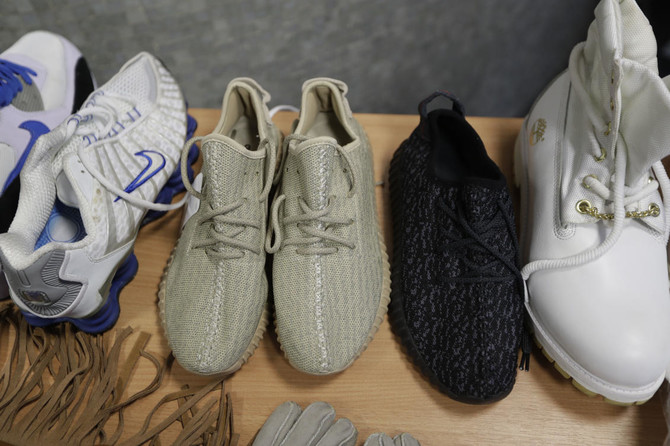
Simi and Haze Khadra discuss the functional vision of their beauty brand and its Middle East launch
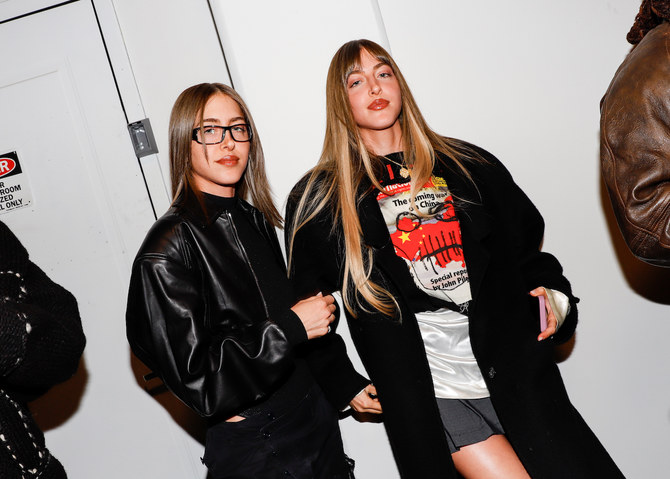
DUBAI: US-Palestinian beauty entrepreneurs Simi and Haze Khadra this week went on tour in the Middle East to launch their brand, SimiHaze Beauty, in the region. Their travels included stops in Saudi Arabia and the UAE.
While in the region, the sister duo — raised by Palestinian parents between Riyadh, London and Dubai — shared insights about their brand with Arab News.
The 31-year-old identical twins, who are also DJs, said that they initially launched the brand out of “pure functionality,” creating products they wanted and needed in their own makeup routines.
Every product they develop undergoes the same rigorous process of ensuring functionality, they said.
“We are constantly thinking of new ideas and ways to make makeup easy and fun to apply,” Simi told Arab News.
The pair launched their US-born cosmetics brand in 2021 with a range of stick-on makeup designs that can be placed on the face for a bold beauty look achievable within seconds.
The sticker book features an array of edgy designs inspired by their favorite DJ looks from the past, such as chrome wings, neon negative space eyeliner and holographic cat-eyes.
SimiHaze Beauty then expanded to include a range of products, such as lipsticks, bronzing powders, and a lifting mascara.
Simi and Haze believe they were “actually late bloomers to the beauty world.”
“We only started becoming interested in it when we were around 18,” Haze said. “We started SHB from just a single product we wanted but couldn’t find in the market, which is our Velvet Blur lipstick.
“We loved a matte lip for every day at the time but couldn’t find one that wasn’t drying, so we created it.”
The twins developed an interest in eye makeup when they began DJ-ing.
“We weren’t the best at applying eyeliner, so again we just created our perfect solution which became the eye stickers,” Haze said.
To the sisters, launching the brand in the Middle East “felt so surreal.”
“The market has been such a huge goal of ours since we started because we grew up here,” Simi said. “We’re so happy that our products are finally accessible to our amazing followers here, because they have been such huge supporters since the beginning.
“Now people are finally able to really see and touch and feel the products, which is so important to us because you will never get the experience and vision of SHB unless you actually hold the product and feel the texture, curves, and ergonomics of it. The online experience doesn’t do it any justice.”
The sisters said that they personally oversee the development of every product. They visit their lab in Italy for a few days at least twice a year to test and create new formulas.
“It takes a while and a lot of back and forth because after we create something it gets tested on our whole family from my grandma to my mom to my little sister and also all my friends with different skin tones,” Simi said.
“My friends are used to me calling them and saying: ‘Hi can I come over and try on some blush colors on you?’ So by the end of it we know what formulas and shades work best on the widest range of people.”
While visiting the Middle East, the sisters observed a prevailing trend in the region: skincare.
“I’ve seen so much good skin here and I can tell people really care about skincare here,” Haze said.
“We’ve also been increasingly obsessed with it. Our products are all infused with skin-loving ingredients, because we’re personally super-paranoid about anything that’s clogging or could cause irritation.”
Loli Bahia, Arab models walk Chanel cruise show in France
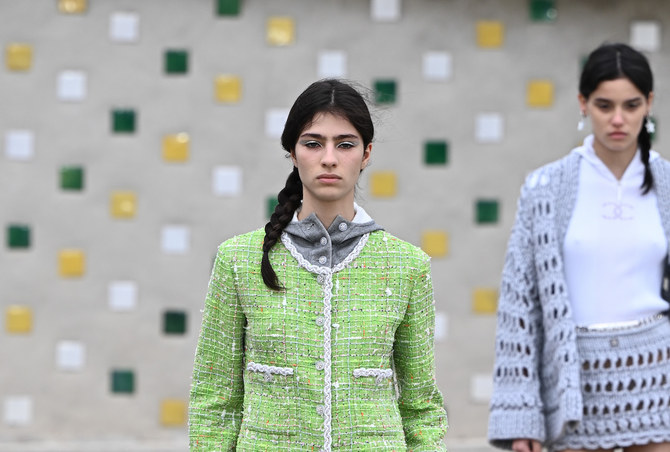
DUBAI: French Algerian model Loli Bahia, British Moroccan Nora Attal, and part-Saudi Amira Al-Zuhair took to the runway at the Chanel Cruise 2024/2025 show in Marseille, France.
Bahia donned a green ensemble, composed of a knee-length pencil skirt paired with a matching top, layered over a white shirt boasting a hoodie collar.
Attal graced the runway in a white summery dress adorned with delicate sheer geometric prints, complemented by white slippers.
Her look also featured beach-inspired layered necklaces, a thin chain belt and chunky bracelets adorned with hat, ship anchors and Chanel logo pendants.
Meanwhile, Al-Zuhair sported a vibrant yellow ensemble featuring hot shorts paired with a button-down top and a coordinating cardigan.
She also wore a beige hat, a gold choker embellished with blue detailing, chunky earrings and a chain belt adorned with pendants.
From intricate embroideries to dazzling sequined jackets and swimwear, Creative Director Virginie Viard’s latest collection showcased ensembles inspired by an underwater reverie.
The outfits included knee-length Bermuda shorts, high-waisted shorts, loose trapeze dresses, and large outerwear. Viard also demonstrated the power of layering, using shirt collars, French cuffs and jackets in unexpected ways throughout the collection.
Earlier this week, Chanel shared a series of images, captured by British photographer Jamie Hawkesworth, on Instagram featuring Bahia. The pictures, drawing inspiration from the seaside and scuba diving, provided an initial preview of Viard’s collection.
Bahia showcased multiple ensembles from the collection in the photographs. In the first shot, she dazzled in a glitzy black sequined mini pencil skirt and blazer. Another image captured her wearing the green ensemble seen on the runway, with the hoodie of the white shirt covering her head.
Additionally, she was photographed donning a white one-piece swimsuit adorned with a black bow around the chest.
The photo series also featured Bahia in a variety of other outfits, including a vibrant white dress with colorful square-like designs, tailored shorts paired with a blazer, as well as a striped set featuring a full-length skirt and matching top.
Saudi Arabia announces Red Sea Fashion Week
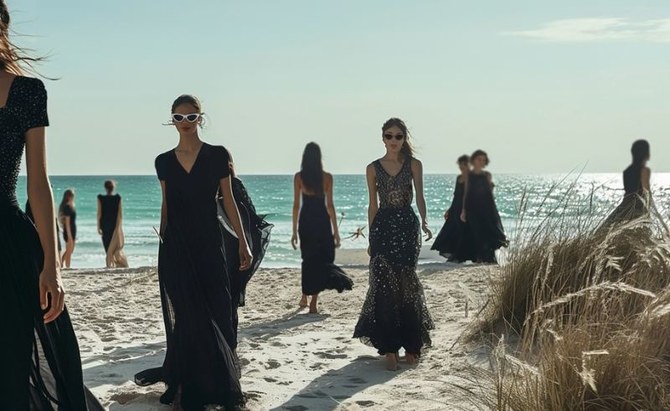
DUBAI: The Kingdom is all set to host the inaugural Red Sea Fashion Week. Set against the waters of Ummahat Island, the glitzy event is scheduled to take place from May 16-18 at The St. Regis Red Sea Resort.
Red Sea Fashion Week, which is organized by the Saudi Fashion Commission, will showcase local and international designers. It aims to celebrate the fusion of traditional Saudi aesthetics with cutting-edge contemporary design.
Among the highlights will be the participation of Saudi 100 Brands, an initiative spearheaded by the Fashion Commission to support and promote emerging local talent.
Saudi Arabia played host to its first fashion week in 2023, in Riyadh. The event took place in the King Abdullah Financial District from Oct. 20-23 and set the stage for a new fashion capital in the Middle East.
Bella Hadid launches Orebella fragrances
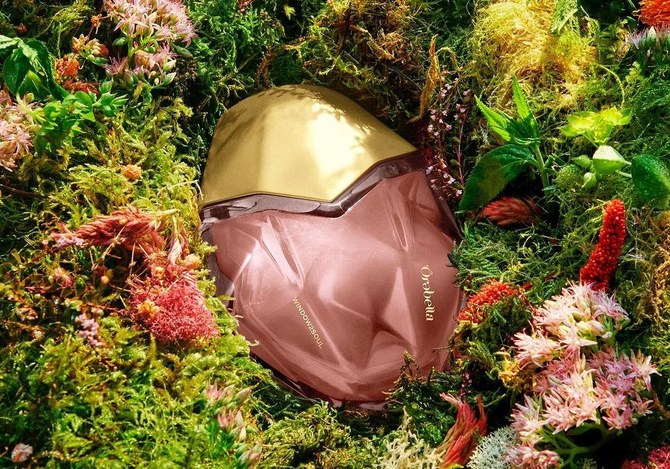
DUBAI: American fashion model Bella Hadid has launched a range of fragrances under her beauty brand, Orebella.
The entrepreneur, of Dutch and Palestinian descent, posted pictures of herself alongside the products — Salted Muse, Blooming Fire and Window2Soul — on Instagram.
The fragrances are available in 10, 50 and 100 mL bottles.
Hadid described them as “hydrating, alcohol-free and enriched with essential oils.”
According to reports, the Salted Muse fragrance has top notes of sea salt, pink pepper and carbon dioxide extract, heart notes of olive tree accord, fig and lavender, and base notes of cedarwood, sandalwood and amber.
Blooming Fire has bergamot, cedarwood, clove leaf and cardamom, followed by Tahitian monoi and jasmine and finishes with patchouli.
Window2Soul has a blend of lemon, geranium and mint in its top notes, transitions to jasmine and damask rose and ends with a base of tonka bean.
“For me, fragrance has always been at the center of my life, helping me feel in charge of who I am and my surroundings,” Hadid said on her website.
“From my home to nostalgic memories, to my own energy and connection with others, scent has been an outlet for me. It made me feel safe in my own world.
“Through my healing journey, I found that I was extremely sensitive to the alcohol in traditional perfumes, both physically and mentally, it became something that was more overwhelming than calming to me.
“That is the main reason I wanted to find an alternative, so essential oils became an artistic and experimental process for me.”
Hadid said she started growing lavender on her farm and learned about her family’s tradition of making scents.
“I realized I might have a calling in this. I found healing, joy and love within nature’s scents.
“This is why I am so proud of Orebella. It was truly a dream and a passion that through the universe and authentic dedication was able to become this brand.”
Riyadh-based soap-maker Mayssam Tamim’s compelling chemistry of Saudi fragrances and flavors
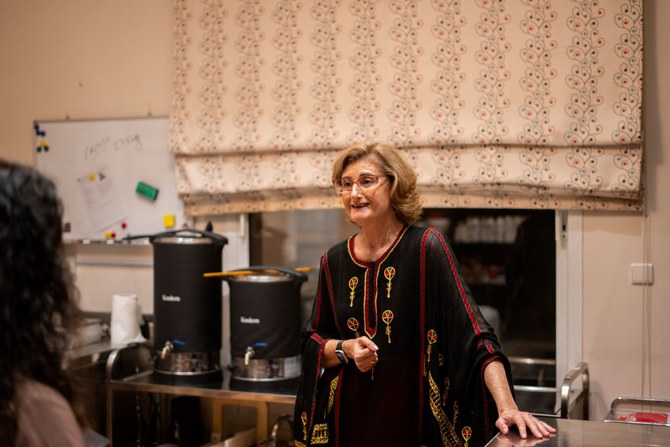
- Businesswoman uses locally-sourced ingredients, no chemicals
- Olive oil, camel milk, honey, dates, Zamzam water key materials
RIYADH: Mayssam Tamim has had a passion for handmade soaps from a young age, and as an adult would search the globe for such products.
She discovered various products in several cities including Tripoli’s eco-friendly creations at Khan Al-Saboun and Provence’s boutique lavender offerings.

In 2018, she decided to set up her own company, the Riyadh-based Mayassem, that produces luxury handmade soaps from Saudi Arabia-sourced natural ingredients.
She told Arab News: “My hope is these soaps, at least a few of the ones that become traditional, are going to help establish something in Saudi Arabia that is considered pure to the region. It doesn’t have to be just my brand of soap, but it can be an industry that is localized.
“We’re doing everything new in Saudi Arabia. Why not this?”

Her products have no harmful chemicals and are handcrafted at her home atelier using sustainable, organic ingredients to ensure that they are gentle on the skin. The materials are locally sourced including extra-virgin olive oil from Al-Jouf, camel milk from Janadriyah, honey from Baha, and dates from Qassim.
She considers the soaps mini canvases, each splashed with a unique blend of non-toxic coloring inspired by their ingredients. The “Bliss” bar for example, made with Zamzam water and lavender fragrance, is crafted to resemble the Kaaba. The “Tamr” bar reflects the palette of the Saudi Arabia landscape as it features oud, saffron and turmeric fragrance, date paste, and camel milk.
“I know it’s a soap and not a painting but sometimes it is a feeling in me. I was very sad at the loss of a cousin, Rana, which in Arabic means song. So for one of my soaps, I decided to go with blue colors and called it ‘Celestial Melody.’ Sometimes it’s just things that simple,” the artisan said.
The soaps come in floral, fruity, woody, citrus, or unscented options. While their main categories are classic, seasonal and signature, she also crafts limited-edition soaps, including an 18-box drop featuring bars encrusted with crystals such as lapis lazuli and black onyx. The brand also offers hand-poured candles made with natural soy, coconut and beeswax, as well as hand cream.
“People can buy soap 10 times cheaper at the supermarket. If I’m not offering them something that adds to the moisturization, that is organic, that does not harm them, and remains beautiful as long as they’re using it, I might as well not start at all,” she said.

With her background in biology, the chemistry of soap-making came naturally to her. She began experimenting, with aesthetics and organic products in mind, over a couple of years until she began testing her final product on family and friends.
After retiring from the UN Development Program, Mayassem began investing her time in her business. Her products have been featured in shops at Jeddah’s Islamic Arts Biennale and Diriyah’s Contemporary Arts Biennale, various homegrown market locations, and pop-up stores.
“I think I’m living the best years of my life because I’m thoroughly working on something that I’m enjoying tremendously. Not to say that I did not enjoy my career. I was very happy with the work I did, but it was time to start a new chapter in my life,” she said.
While artisans have been embedded in local culture for ages, the brand aims to call attention to their value by keeping the business hand-crafted and artisanal in line with its ethos. “I don’t want it to become a job. I want it to stay a passion,” she said. “Artisans, whether they’re making soap, embroidery, or painting, bring out the value in a country. And we have different regions, so it also brings out the identity of a country.”














